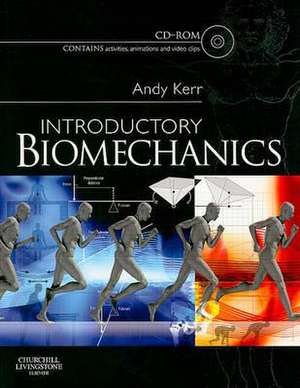Introductory Biomechanics
Autor Andrew Kerren Limba Engleză Paperback – 25 ian 2010
Introductory Biomechanics uses workbook-style learning diffusing manageable chunks of theory with learning activities and ultimately making the link back to clinical application. The accompanying CD is closely tied in with the text, containing video clips and real motion analysis data of walking, jumping, cycling and rising from a chair. There are also numerous animations of principles in action. The user is in control of most clips and animations and can change settings and manipulate variables practically showing biomechanics in action. The CD also contains a dynamic quiz drawing randomly from a pool of over 70 questions (MCQs, fill-in-the-blanks, true/false) which also provides feedback and percentage score on completion.
Preț: 194.84 lei
Preț vechi: 217.18 lei
-10% Nou
Puncte Express: 292
Preț estimativ în valută:
37.29€ • 40.52$ • 31.35£
37.29€ • 40.52$ • 31.35£
Carte tipărită la comandă
Livrare economică 18-29 aprilie
Preluare comenzi: 021 569.72.76
Specificații
ISBN-13: 9780443069444
ISBN-10: 0443069441
Pagini: 166
Dimensiuni: 189 x 246 x 246 mm
Greutate: 0.34 kg
Editura: Elsevier
ISBN-10: 0443069441
Pagini: 166
Dimensiuni: 189 x 246 x 246 mm
Greutate: 0.34 kg
Editura: Elsevier
Public țintă
Physiotherapists, sports science and exercise professionals, podiatrists, occupational therapistsCuprins
Introduction
Chapter 1 Fundamentals of force What is force? What does mechanical force do Scalar or Vector? Drawing vectors Point of application Force magnitude and change in motion The force of muscles Magnitude of moments Direction of moments
Chapter 2 Gravity, mass and stability Gravity: the ultimate force Centre of mass Calculating the centre of mass. Moments created by mass Stability Local and general stability Standing balance
Chapter 3 Force analysis: Graphs and maths How do forces combine? The Q-angle and knee pain Measuring force Using mathematics to resolve force
Chapter 4 Forces and motion Inertia Moment of inertia Linear momentum Rotational momentum Conservation of angular momentum Newton's second law: Impulse and momentum Newton's third law: Action and reaction Bodies in contact: pressure and friction Centre of pressure Friction
Chapter 5 Work and machines Work Muscles at work Direction of work Using machines to do work Categories of levers Velocity ratio More advanced machines Pulleys The power of work Efficiency Practical problems on force and human movement
Chapter 6 Stress and strain Definitions Stress Strain Stress-strain relationship and stiffness A few other properties of materials
Chapter 7 Composition and mechanical properties of connective tissue Connective tissue Skin Muscle Bone Articular cartilage Tissue remodelling Inactivity (immobilisation) Maturation Effect of ageing Effect of recent history Temperature Science of stretch
Chapter 8 Flow Relative density Hydrostatic pressure Archimedes principle, buoyancy and Pascal's law Take the pressure off Air pressure Mechanics of flow Drag Bernoulli's principle Blood flow: haemodynamics
Chapter 9 Energy and movement What energy is Potential and kinetic energy Elastically stored potential energy Energy conservation Muscle energy Measuring energy during movement
Chapter 10 Therapeutic application of force Mobilization techniques Static stretching Respiratory techniques Hydrotherapy Orthoses Dynamic wrist splints
Chapter 1 Fundamentals of force What is force? What does mechanical force do Scalar or Vector? Drawing vectors Point of application Force magnitude and change in motion The force of muscles Magnitude of moments Direction of moments
Chapter 2 Gravity, mass and stability Gravity: the ultimate force Centre of mass Calculating the centre of mass. Moments created by mass Stability Local and general stability Standing balance
Chapter 3 Force analysis: Graphs and maths How do forces combine? The Q-angle and knee pain Measuring force Using mathematics to resolve force
Chapter 4 Forces and motion Inertia Moment of inertia Linear momentum Rotational momentum Conservation of angular momentum Newton's second law: Impulse and momentum Newton's third law: Action and reaction Bodies in contact: pressure and friction Centre of pressure Friction
Chapter 5 Work and machines Work Muscles at work Direction of work Using machines to do work Categories of levers Velocity ratio More advanced machines Pulleys The power of work Efficiency Practical problems on force and human movement
Chapter 6 Stress and strain Definitions Stress Strain Stress-strain relationship and stiffness A few other properties of materials
Chapter 7 Composition and mechanical properties of connective tissue Connective tissue Skin Muscle Bone Articular cartilage Tissue remodelling Inactivity (immobilisation) Maturation Effect of ageing Effect of recent history Temperature Science of stretch
Chapter 8 Flow Relative density Hydrostatic pressure Archimedes principle, buoyancy and Pascal's law Take the pressure off Air pressure Mechanics of flow Drag Bernoulli's principle Blood flow: haemodynamics
Chapter 9 Energy and movement What energy is Potential and kinetic energy Elastically stored potential energy Energy conservation Muscle energy Measuring energy during movement
Chapter 10 Therapeutic application of force Mobilization techniques Static stretching Respiratory techniques Hydrotherapy Orthoses Dynamic wrist splints
